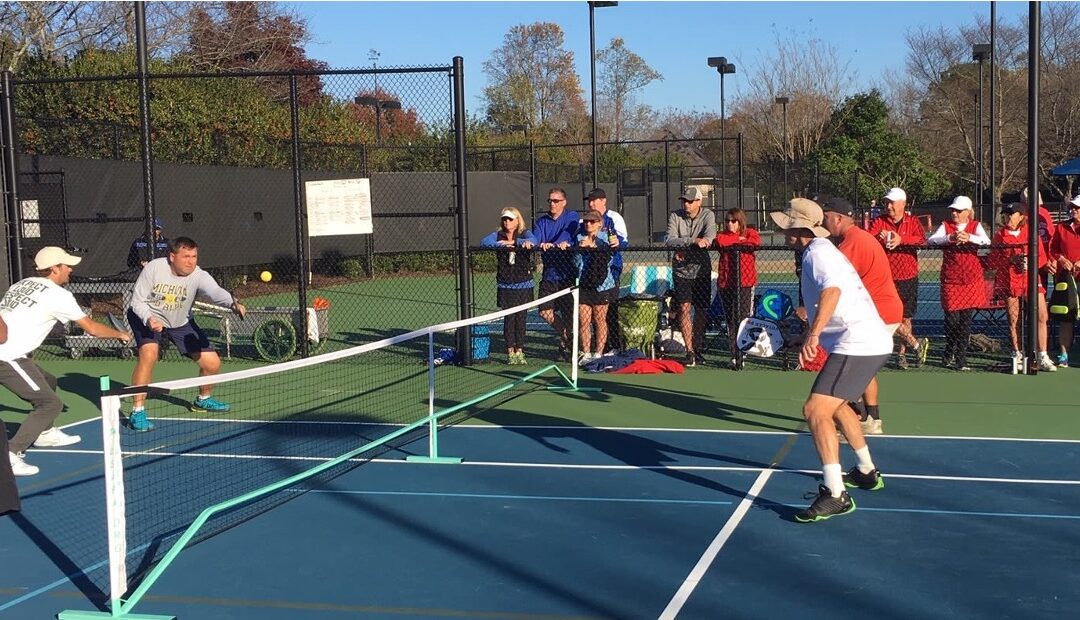Dinking is one of the most important parts of any player’s pickleball game, and one of the most important skills to master. To many, it appears simple and easy however it takes touch, strategy and practice – or else you’ll end by popping the ball up and getting it slammed back at you. This article is all about pickleball dinking: tips and strategies. Enjoy!
Getting to the Non-Volley Zone / The Kitchen
In Pickleball, many points are won and lost at the kitchen line. This makes getting to the kitchen essential. There are many shots which help you and your partner get to the kitchen. Which shot you use is dependent on your opponents, the flow of the shots and your skills.
Typically, the receiving team in pickleball gets to the kitchen first. They already have a player up at the kitchen when the serve is hit, and the other player typically moves to the kitchen quickly once he / she returns the serve. Because of the double bounce rule in pickleball, the serving team must stay back, allowing the ball to bounce before hitting the third shot.
The third shot can be one of several variations: third shot drop, third shot lob, drive. For purposes of this article, let’s move the play to where all four players are at the kitchen line after slowing down the game. This is where the dinking fun begins.
Pickleball Dinking
In pickleball, dinking is about extending the game as long as possible until your opponent makes a mistake. It takes patience and persistence to be a good pickleball dinker – along with good form / technique. There are two main types of dinks – the volley and the groundstroke, however there are many variations of each.
Use Your Legs (Technique)
Many pickleball beginners will dink by moving their writs or using all arms. This will cause inconsistent shots and many unforced errors. I like to lock my write and use my legs to help “push” the ball over the next with accuracy. Pick a spot where you want the shot to go and use your body (not just your wrists) to execute the shot. Understanding and learning to use proper dinking technique will improve your success at the net during dink rallies.
Volley Dink
A volley dink is when you hit the ball out of the air, without letting it bounce. This shot tends to have more pace than the groundstroke dink as it will bounce off the face of your paddle faster and will travel further. As you practice and improve this skill, you’ll notice that you tend to have to loosen your grip on the paddle. A volley dink can be a more advanced shot too, as it takes time away from your opponents (more on this below).
Groundstroke Dink
The groundstroke dink then is when you let the ball bounce first before returning the shot. Due to physics, allowing the ball to bounce will inherently take some speed off the ball. It’s important to understand that allowing the ball to bounce gives you a bit more time to execute your shot. Pickleball beginners don’t realize that they have more time than they think to prepare and to hit their return shot / dink.
Cross-Court Dink
The cross-court dink is the most important dink shot to learn when it comes to dinking. This is a shot that you hit at an angle to the other side of your opponent’s court. It’s simple in concept, but not in execution.
There are many ways to perform a cross-court dink. You can do it underhanded or backhanded. You can hit the ball with top sin, backspin or with a slice for sidespin. Most pickleball beginners and intermediate players will perform what’s called a “push dink”. This is when you hit the ball with an underhand motion, “pushing” the ball over the net (hopefully to a strategic location on the court).
Straight-Ahead Dink
This is the most simple type of dink shot in pickleball. The straight-away dink is simply a dink that goes straight ahead of you. These are the types of shots that you typically warm up with before a pickleball game / match. The straight-away dink becomes important when it’s used as a fallback for a tough cross-court dink that was made by your opponent.
The Dreaded “Dead” Dink
This is the shot you want to avoid. Next to a pop-up, this shot can get you into trouble. A “dead” dink is a shot which typically bounces high, has little to no spin and does not stress your opponent. “Dead” dinks are typically very attackable by your opponent, thus putting you on the defensive quickly – if your opponent doesn’t hit a winner as a result.
Pickleball Dinking Strategy
Again, dinking is about making your opponents make the mistake, not making you win the shot. Patience is key in dinking rallies. The main strategy in pickleball dinking is to move your opponent around the court and set up either an attacking shot or forcing your opponent to make an error.
Dink to the Backhand Foot
One of my favorite shots is to hit a dink to the backhand foot of my opponent. During a rally I may push or slice a dink several times in a row to my opponents backhand foot, moving them farther out towards the sideline of the court. I watch the other players position on the court to see if they move over to help support the middle. If they leave the middle open, I attack down the middle into open space. If the opponents partner moves towards the middle, I wait until a dink return shot is higher or bounces higher, then I attack down the line. This is my M.O.! Most of the people I play against know my M.O. however they can’t always stop it because I’m more strategic on the court than most.
The Re-Set Dink
At times, a dinking rally can get frantic with players pushing each other all over the court. For instance, in a cross-court dinking rally, at times a good re-set is to push a short straight-ahead dink. This can slow the rally down and allow you and your partner to reset your positions on the court.
Attacking Lob
Another great shot during a frantic dink rally is the lob shot. During a dink rally, it’s typical that the players are all on their toes, leaning forward with expectation of another dink. If you notice this happening, it might be a good idea to mix in a lob shot. I like to lob to the back corner over the backhand shoulder of my opponent. A backhand overhead shot is much harder than a forehand smash. Also, a lob shot during a dink rally can also help reset your positioning with your partner.
If you lob, YOU CAN’T BE SHORT or the ball will come back with significant pace. Be careful, but also use this shot strategically. It’s a good one!
Key Dinking Strategies
- Hit the ball out of the air, if possible. This allows you to take time away from your opponent. Meaning, the ball is coming back to them before they are potentially ready, thus putting more stress on their next shot. As mentioned above though, be aware that volley dinking requires a slightly different touch / skill than groundstroke dinking.
- Mix up your dinks and move your opponents around the court. Use cross-court, straight ahead and spin dinks. When in doubt, hit to your opponents backhand foot.
- Attack “dead” dinks. If your opponent gives you a “dead” dink on a platter, make them pay for it. Attack! Hit an aggressive shot down the middle, down the line or at the paddle side shoulder / hip.
- Move with and communicate with your partner. If your partner is being pushed out wide, move when them to cut down angles. Always be ready for a speed up / attack. And if a dink comes to the middle, communicate with your partner by saying “Mine” or “Yours” or something you both prefer to say to each other. Also, the player with the forehand shot tends to be the primary player, however communicate with your partner if you have a better shot or if you are in a more balanced / better position.
- Reset with a straight ahead dink, if needed. At times, you’re going to need to reset at the kitchen. If you are getting stressed or if there are some challenging dinks coming your way, reset and regroup. Don’t try to hit low percentage return dinks when being stressed. Take a step back if you need to, and hit a dink that will allow you to get back under control
Dinking Drills
To master this skill and all of its variations, it’s great to drill with your partner. I’ve done this many time and it’s fun. Hit 50 consecutive dinks with your partner, without making a mistake, before moving on to the next shot. So, hit 50 cross court dinks in row…then switch sides for another 50 cross court dinks. If either of your make an error, start over from 1 again.
Have fun and enjoy! Let’s go!

